At the Tate Modern Part I: Cecilia Vicuña
We missed the Cecilia Vicuña full installation. It was being taken down when we were there, but the label and a piece of it was still
visible
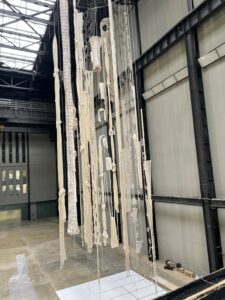
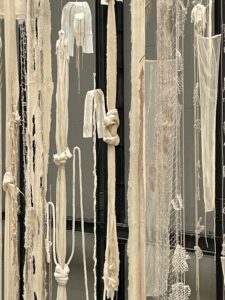
Since I didn’t fully experience it, I give you the label information:
“In the Andes people did not write, they wove meaning into textiles and knotted cords. Five thousand years ago they created the quipu (knot), a poem in space, a way to remember, involving the body and the cosmos at once. A tactile, spatial metaphor for the union of all. The quipu and its virtual counterpart, the ceque ( a system of sightlines connecting all communities in the Andes) were banished after the European Conquest. Quipus were burnt, but the quipu did not die. It symbolic dimension and vison of interconnectivity endures in Andean culture today.” Cecilia Vicuña
“27 meters pale ghostly, quipu sculptures hang from the ceiling at opposite ends of the Turbine Hall. Cecilia Vicuña’s Brain Forest Quipu continues her long-standing work with the ancient Andean tradition of the quipu. Woven together from different materials including found objects, unspun wool, plant fibres, rope and cardboard, the sculptures are combines with music and voice that emerge at mements as you move through the space.
This multi-media installation is an act of mourning for the destruction of the forests, the subsequent impact of climate change, and the violence against indigenous peoples. It is also an opportunity to create a space for new voices and forms of knowledge to be heard and understood, as we take responsibility for our part in the destruction.
Vicuña’s reimagining of the quipu contains a number of layers, sculptural, sonic, social and digital. She invites us into the “Dead Forest Quipu,” a pair of sculptures whose skeletal forms draw attention to the severity of the climate crisis and the delicate nature of our ecosystems. Their bone-white colour reminds us of bleached bark of trees killed by drought or intentional fire and other dried-out substances like snakeskin.
Placing the sculptures at either end of the Turbine Hall, Vicuña creates an alternative architecture binding the two ends of the space. Made from a range of organic materials and items collected from the banks of the River Thames by women from local Latin American communities, the work extends Vicuña’s practice of assembling found, imperfect and modest materials that she calls precarios (precarious).
The ‘Dead Forest Quipu’ sculptures are accompanied by a ‘Sound Quipu’ playing from within the sculpture and under the bridge. This sonic element, conceived by Colombian composer Ricardo Gallo, brings together indigenous music from several regions, compositional silences, new pieces by Gallo, Vicuña, and other artists, and field recordings from nature.
The interwoven moments of sound and silence span 8 hours of sonic breathing and symbolize the earth’s life in the face of the loss taking place across the globe.
The ‘Digital Quipu’ weaves together videos of indigenous activists and land defenders from regions around the world who are using digital platforms to amplify their calls. Shown on video monitors throughout the building and online, the Digital Quipu offers political and economic context for the material realities faced by communities in the ongoing struggle to protest and preserve their respective ancestral territories, communities and traditions.
What Vicuña describes as the ‘social weaving’ will extend through a ‘Quipu of Encounters: Rituals and Assemblies’. This series of global events, or ‘knots of action’, connect ancient Andean tradition and contemporary culture, inviting visitors to become active participants in the prevention of climate catastrophe.
Vicuña writes ‘ the Earth is a brain forest and the quipu embraces all its interconnections.’ Brought together , the elements of Brain Forest Quipu emphasize the contradiction and complexity of our time. This entanglement of our bodies – with both the material world of nature and the places that we live – is enmeshed in the hive-mind of technology that connects us with each other, while isolating us in new and often uncertain ways.
Vicuña suggests that we are at the beginning of a new time, one where we must first become aware of our collective responsibility in order to change destructiveness, injustices and harm. Through Brain Forest Quipu she invites us to create spaces for imagining and dreaming so that we can ‘bring our heart-minds together to give life to a new forest in a spirit of reparation.’”
Here are a few press photos:
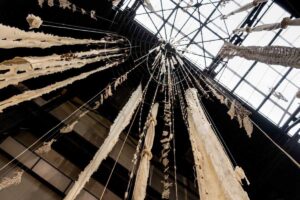
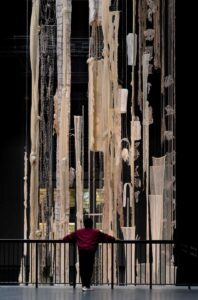
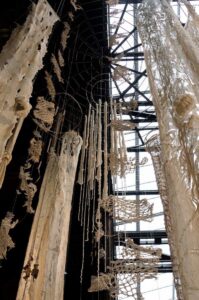
We had a Cecilia Vicuña exhibition in Seattle in June 2019 that I wrote about on this blog. On that occasion I was fortunate to attend a poetry reading performance at which we created a community by winding a quipu around us.
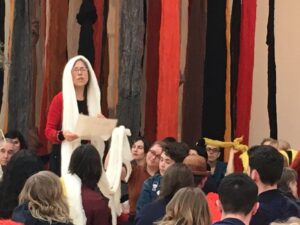
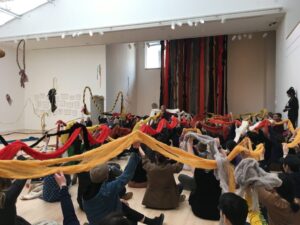
We can hope that the survival of this ancient knowledge which colonialism tried so hard to wipe out, will also provide us with a way to the future on our troubled planet.
This entry was posted on May 12, 2023 and is filed under Uncategorized.








